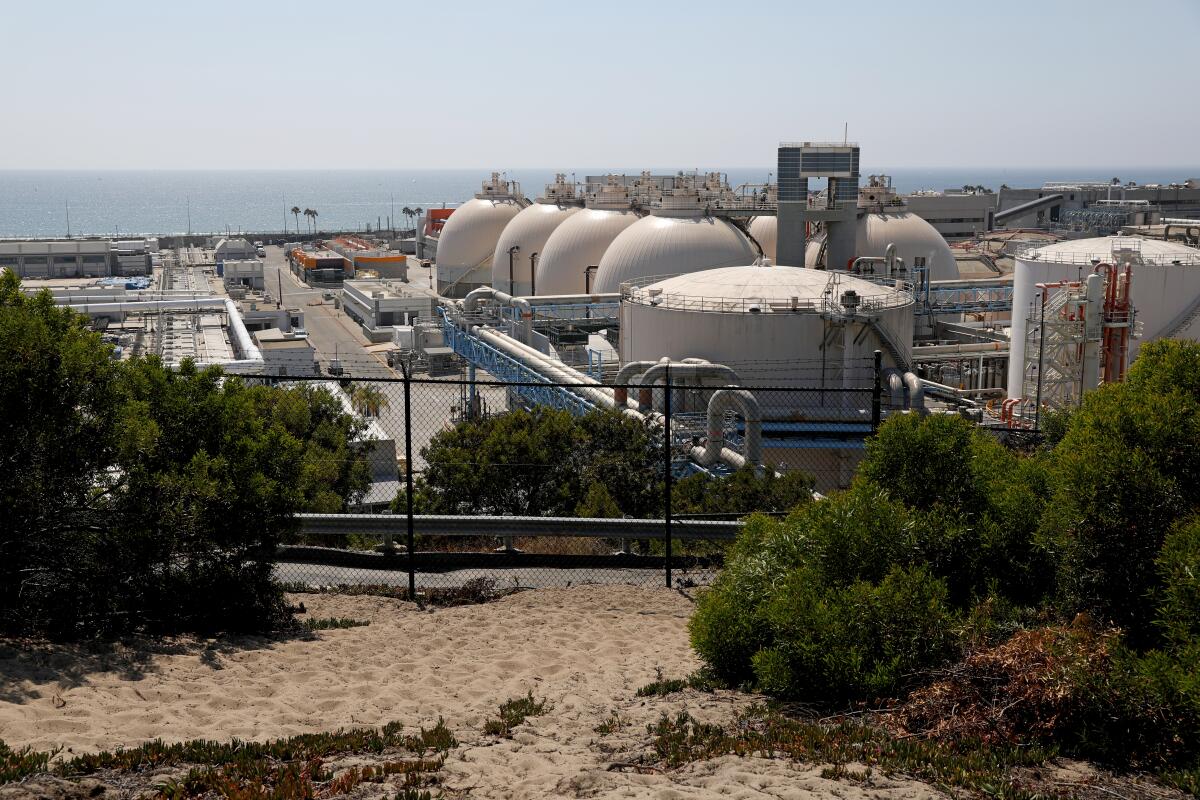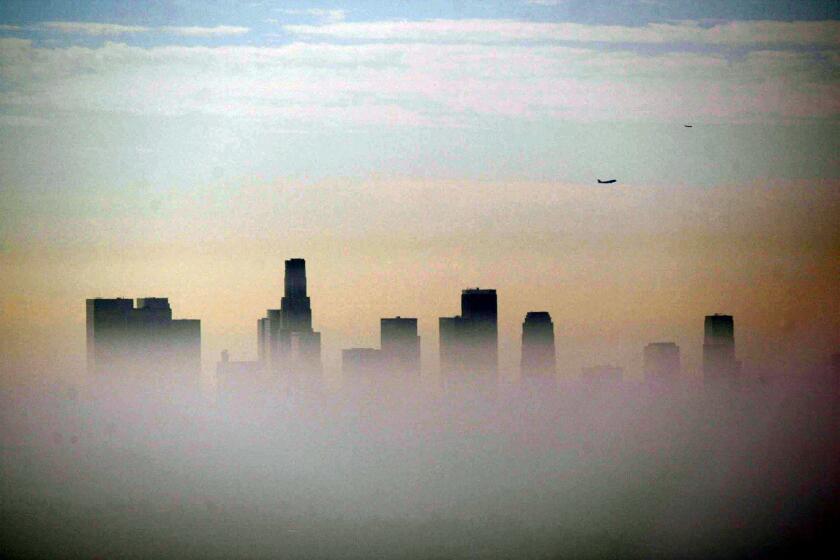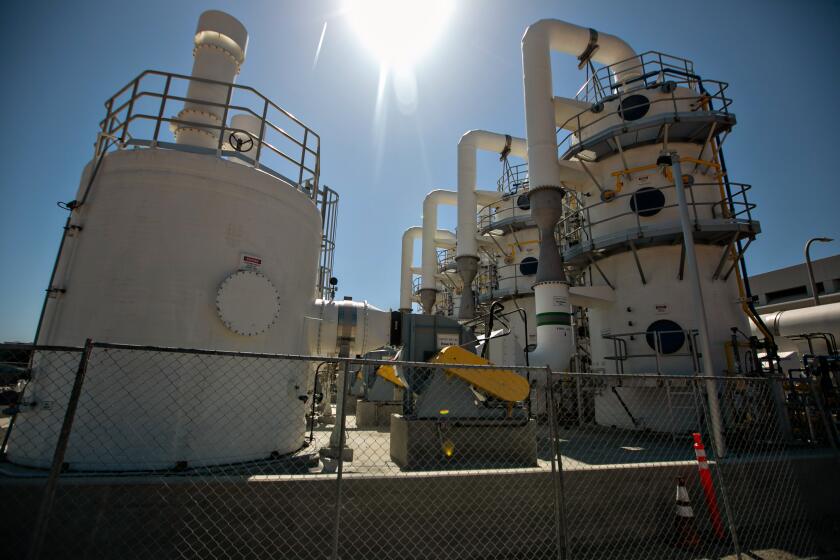Massive sewage spill could cost L.A. city up to $21.7 million in fines

State regulators have proposed a record $21.7-million penalty for breakdowns and failures at Los Angeles’ largest wastewater treatment facility that triggered a massive sewage spill in the Santa Monica Bay and led to noxious fumes and water-quality problems that persist almost two years later.
The Hyperion Water Reclamation Plant reported more than 150 violations of its environmental permit, including failure to comply with ocean monitoring and reporting requirements after torrents of raw sewage flooded the facility in July 2021 and resulted in more than 12 million gallons of wastewater spewing into the Pacific off Dockweiler Beach, according to state regulators.
In a civil liability complaint, the Los Angeles Regional Water Quality Control Board accused officials at the Hyperion plant in Playa del Rey of “gross negligence” in connection with multiple breakdowns. They included failing to maintain equipment designed to remove solid refuse from incoming wastewater and a lack of emergency protocols, as well as delays in cleaning up sewage strewn across the 145-acre facility and repairing damaged systems, all of which “led to additional compliance issues.”
The 57-page complaint provides new details about one of the largest sewage spills in Santa Monica Bay in decades and paints a troubling picture of water treatment operations at the plant, which is expected to play a crucial role in an ambitious plan to recycle wastewater for potable use by 2035 and reduce the city’s reliance on imported water.
Around 38.5 million California residents live in a county that received a failing grade in the Lung Assn.’s annual “State of the Air” report.
The penalty, which will be finalized at a public hearing to be scheduled in the coming weeks, is the largest proposed by the Los Angeles water board and is nearly twice the amount of the previous record for dumping hazardous substances into the Dominguez Channel near Carson after a 2021 warehouse fire.
“The amount of the proposed penalty reflects the seriousness of the permit violations at the plant and the scale of the harm to our region,” water board Assistant Executive Officer Hugh Marley said in a news release.
The L.A. Sanitation and Environment Department, which operates the facility, said in a statement that resolving issues related to the sewage spill “remains a top priority.”
Since the July 2021 spill, sanitation officials have fast-tracked projects to improve plant infrastructure and are working with federal and state regulators, the agency said, noting that Hyperion is meeting its water-quality requirements.
Sanitation officials previously lauded the “valiant” efforts of Hyperion crews, saying their actions prevented a larger environmental disaster.
Hyperion officials initially blamed the flooding on a deluge of concrete and wood illegally dumped into the city’s sprawling sewer system, but a report commissioned last year by the city concluded that equipment failures, unheeded alarms and insufficient staffing were the likely causes.
After the flooding, sanitation officials said that about 17 million gallons of raw sewage was directed into the ocean through a one-mile pipe. But that figure was lowered after more than 4 million gallons of sewage was found in the pipe and pumped back to the facility, a water board spokeswoman said.
The incident, which continued for more than 12 hours as crews scrambled to stem the flow of sewage, has prompted at least three lawsuits and sparked thousands of complaints about foul odors, nausea and rashes from residents in adjacent El Segundo.
Diminished water quality at the facility has also hampered water-purification efforts in the region.
A study finds ‘little or no evidence’ that illegally dumped debris caused the July spill in Santa Monica Bay — as sanitation officials initially said.
The Hyperion facility sends a portion of its treated wastewater each day to a nearby plant run by the West Basin Municipal Water District, where crews further treat the water for irrigating greenbelts, parks and other recycling uses.
But the quality of Hyperion’s water continues to fluctuate, forcing West Basin crews to blend drinking water into the recycled water they produce, spokeswoman Amy Rocha said.
So far, she said, the district has used about 10,000 acre-feet of drinking water, or enough to supply roughly 30,000 average households for a year.
Hyperion officials said this week that they are working with West Basin to address its concerns.
In response to the ongoing noxious odors, El Segundo declared a state of emergency in September and filed a lawsuit against the city of Los Angeles.
In interviews this week, El Segundo residents said they continue to smell foul odors.
“It’s still common,” said Neal Boushell, 55, who lives east of the facility. He is remodeling his home and plans to install an indoor air filtration system to guard against noxious odors spewed by the Hyperion plant.
Just three blocks from his Palm Avenue home, Boushell said, the smell is much worse and “doesn’t ever go away.”
How did a dirt parking lot in the San Gabriel Mountains become a major flyway for migrating birds? Scientists can only guess.
Weeks after the July 2021 spill, The Times reported that Hyperion was continuing to discharge polluted water into the Santa Monica Bay in violation of its environmental permit. For 10 months after the incident, the facility continued to exceed acceptable permit levels for the wastewater it was releasing into the ocean and committed 38 “serious violations,” according to the complaint.
The complaint said that Hyperion officials monitoring offshore locations also reported seeing “oil sheen, grease balls, tar, plastic debris and other floating materials.”
The water board ordered Hyperion officials to conduct offshore monitoring of water quality and submit status reports, but the facility failed to do so on multiple occasions, regulators said in the complaint.
The complaint also detailed a series of troubling operational breakdowns at the plant, where the city has invested more than $550,000 in recent years to upgrade equipment and systems.
Officials failed to fully automate huge metal screens that rake solid material from incoming wastewater, reducing their efficiency, regulators noted in the complaint. Those screens malfunctioned and contributed to the flood of raw sewage.
Crews regularly left a huge bulkhead, which weighs about 3 tons, over an emergency bypass opening in the floor of the building that initially flooded. “This practice was unnecessary,” the complaint said, and was a “critical element” that prevented workers from diverting rising wastewater that sent them fleeing for their lives.
Regulators faulted Hyperion crews for failing to respond quickly to a host of problems in the days and months after the incident as the damaged facility struggled to resume normal operations.
“There was a delay in response, recovery and cleanup,” the complaint said, leading to “additional compliance issues which then prolonged the amount of time it took for the [facility] to come back into compliance.”










